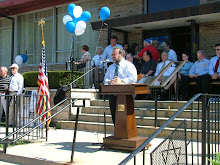[http://static.jpost.com/images/2002/site/jplogo.gif]
Inscription indicates Kingdom of Israel existed in the 10th century BCE
Jan. 8, 2010
JPost.com Staff , THE JERUSALEM POST
A breakthrough in the research of the Hebrew scriptures has shed new light =
on the period in which the Bible was written, testifying to Hebrew writing =
abilities as early as the 10th century BCE, the University of Haifa announc=
ed on Thursday.
Prof. Gershon Galil of the Department of Biblical Studies at the University=
of Haifa recently deciphered an inscription dating from the 10th century B=
CE, and showed that it was a Hebrew inscription, making it the earliest kno=
wn Hebrew writing.
The significance of this breakthrough relates to the fact that at least som=
e of the biblical scriptures were composed hundreds of years before the dat=
es presented today in research and that the Kingdom of Israel already exist=
ed at that time.
The inscription itself, which was written in ink on a 15 cm X 16.5 cm trape=
zoid pottery shard, was discovered a year and a half ago at excavations tha=
t were carried out by Prof. Yosef Garfinkel at Khirbet Qeiyafa near the Ela=
h valley.
The inscription was dated back to the 10th century BCE, which was the perio=
d of King David's reign, but the question of the language used in this insc=
ription remained unanswered, making it impossible to prove whether it was i=
n fact Hebrew or another local language.
Prof. Galil's deciphering of the ancient writing testifies to its being Heb=
rew, based on the use of verbs particular to the Hebrew language, and conte=
nt specific to Hebrew culture and not adopted by any other cultures in the =
region.
"This text is a social statement, relating to slaves, widows and orphans. I=
t uses verbs that were characteristic of Hebrew, such as asah ("did") and a=
vad ("worked"), which were rarely used in other regional languages. Particu=
lar words that appear in the text, such as almanah ("widow") are specific t=
o Hebrew and are written differently in other local languages," Prof. Galil=
explained.
The deciphered text:
1' you shall not do [it], but worship the [Lord].
2' Judge the sla[ve] and the wid[ow] / Judge the orph[an]
3' [and] the stranger. [Pl]ead for the infant / plead for the po[or and]
4' the widow. Rehabilitate [the poor] at the hands of the king.
5' Protect the po[or and] the slave / [supp]ort the stranger.
Once this deciphering is received, Prof. Galil added, the inscription will =
become the earliest Hebrew inscription to be found, testifying to Hebrew wr=
iting abilities as early as the 10th century BCE. This stands opposed to th=
e dating of the composition of the Bible in current research, which would n=
ot have recognized the possibility that the Bible or parts of it could have=
been written during this ancient period.










No comments:
Post a Comment